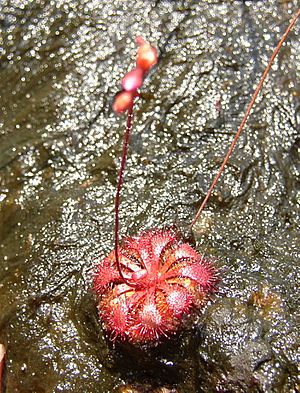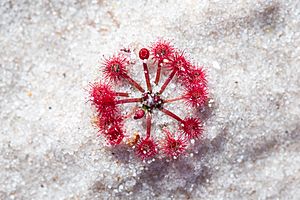Spoon-leaved sundew facts for kids
Quick facts for kids Spoon-leaved sundew |
|
|---|---|
 |
|
| Drosera spatulata var. bakoensis | |
| Scientific classification | |
| Genus: |
Drosera
|
| Species: |
spatulata
|
The Drosera spatulata, also known as the spoon-leaved sundew, is a fascinating carnivorous plant. It grows in a flat, circular shape, like a rosette, and has unique spoon-shaped leaves. Its scientific name, spatulata, comes from Latin and means "spatula shaped," which perfectly describes its leaves.
This amazing sundew can be found across a huge area! It grows naturally in places like Southeast Asia, southern China, Japan, Micronesia, New Guinea, and even in eastern Australia, Tasmania, and New Zealand. Different types of this plant are often named after the places where they are found. Unlike some other plants, it doesn't go into a winter sleep (called hibernacula). It's also quite easy to grow, similar to another popular sundew, Drosera capensis.
Some people who grow carnivorous plants actually see D. spatulata as a bit of a "weed." This is because it's very tough and produces lots of seeds when it flowers. These seeds also sprout easily, meaning little sundew plants can pop up in nearby pots! It's also good to know that many plants sold as "D. spatulata" might actually be Drosera tokaiensis instead.
What Does the Spoon-Leaved Sundew Look Like?
The Drosera spatulata is a perennial plant, meaning it lives for more than two years. It forms small rosettes (circular clusters) of many spoon-shaped leaves. While this plant can look a bit different depending on where it grows, it's usually about 4 cm (1.6 in) wide.
Each leaf connects to the center of the rosette with a thin stem, about 8 mm long. Only the top half of this stem is sticky. The main part of the leaf is typically 5 mm long and 4 mm wide. In early summer, these plants grow tall, straight flower stalks, about 8 cm (3.1 in) high. Each stalk has about six small white or pink flowers. These flowers grow on one side of the stalk and can be up to 6 mm across.
How Was This Plant Discovered?
The Drosera spatulata was first officially described by a scientist named Jacques Labillardière in his book from 1804. A few years later, in 1824, another scientist, Augustin Pyramus de Candolle, included it in his own book. However, he accidentally misspelled its name as Drosera spathulata. This incorrect spelling is still sometimes used today!
Since its first description, this plant has been given a few other names, but these are now considered the same as D. spatulata. Scientists have also found two different types, or varieties, of Drosera spatulata. The first one, called Drosera spatulata var. gympiensis, was described in 2005. It has consistently hairy parts on its flowers. In 2009, another variety, Drosera spatulata var. bakoensis, was found in Bako National Park in Sarawak, Borneo.




